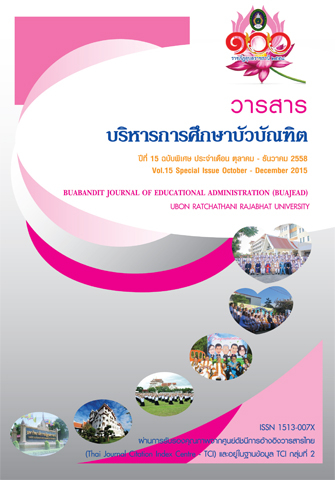การพัฒนารูปแบบการจัดการเรียนรู้แบบ KID-D เพื่อเสริมสร้างคุณลักษณะสังคหวัตถุสี่ของเด็กปฐมวัย
Main Article Content
บทคัดย่อ
การวิจัยครั้งนี้มีวัตถุประสงค์เพื่อเสริมสร้างคุณลักษณะสังคหวัตถุสี่ของเด็กปฐมวัย ด้วยรูปแบบ การจัดการเรียนรู้แบบ KID-D ทำการศึกษาเป็นสามระยะ ดังนี้ 1) วิเคราะห์องค์ประกอบคุณลักษณะสังคหวัตถุสี่ ของเด็กปฐมวัย 2) สร้างรูปแบบการจัดการเรียนรู้ และ 3) เสริมสร้างคุณลักษณะสังคหวัตถุสี่ของเด็กปฐมวัย โดยใช้รูปแบบการจัดการเรียนรู้แบบ KID-D กลุ่มตัวอย่างที่ใช้ในการวิจัยเป็นนักเรียนชั้นอนุบาลปีที่ 2 อายุ 5-6 ปี โรงเรียนสังกัดสำนักการศึกษากรุงเทพมหานคร ปีการศึกษา 2557 แบ่งเป็นกลุ่มตัวอย่างในการศึกษาองค์ประกอบ จานวน 525 คน ซึ่งได้จากการสุ่มตัวอย่างแบบแบ่งกลุ่ม (Cluster Sampling) และกลุ่มตัวอย่างที่ใช้ในการเสริมสร้าง คุณลักษณะสังคหวัตถุสี่ จำนวน 2 ห้องเรียน ที่ได้จากการเลือกแบบเจาะจง แบ่งเป็นกลุ่มทดลอง จำนวน 37 คน ได้รับการจัดการเรียนรู้แบบ KID-D และกลุ่มควบคุม จำนวน 37 คน ได้รับการจัดการเรียนรู้ตามแบบปกติของ โรงเรียน เครื่องมือที่ใช้ คือ แบบประเมินคุณลักษณะสังคหวัตถุสี่ของเด็กปฐมวัยและรูปแบบการจัดการเรียนรู้ แบบ KID-D
ผลการศึกษาสรุปได้ดังนี้ การวิเคราะห์องค์ประกอบเชิงยืนยันคุณลักษณะสังคหวัตถุสี่ของเด็กปฐมวัย พบว่า คุณลักษณะสังคหวัตถุสี่ของเด็กปฐมวัย มี 4 องค์ประกอบ ได้แก่ ด้านการให้สิ่งที่ดี มี 3 ตัวบ่งชี้ ด้านการพูดดี มี 3 ตัวบ่งชี้ ด้านประพฤติดี มี 3 ตัวบ่งชี้ และด้านการวางตนดี มี 3 ตัวบ่งชี้ โดยทั้งโมเดลการวิเคราะห์องค์ประกอบ อันดับแรกและอันดับที่สอง มีความเหมาะสมพอดีกับข้อมูลเชิงประจักษ์และมีค่าน้ำหนักการถดถอยมาตรฐาน ที่แสดงค่าความเที่ยงตรงเชิงโครงสร้างสูงและมีค่าสหสัมพันธ์เชิงพหุกำลังสอง ที่แสดงค่าความเชื่อถือได้สูงในแต่ละ ตัวบ่งชี้ ส่วนผลการสร้างรูปแบบการจัดการเรียนรู้ได้รูปแบบการจัดการเรียนรู้แบบ KID-D ประกอบด้วย 4 ขั้นตอน คือ ขั้นการกระตุ้นความรู้ (Knowledge : K) ขั้นการปฏิสัมพันธ์ (Interaction : I) ขั้นการปฏิบัติงานร่วมกัน (Doing Together: D) และขั้นการแสดงผลงานสะท้อนการเรียนรู้ (Display : D) ที่มีคุณภาพโดยรวมอยู่ในระดับเหมาะสมมาก และผลการเสริมสร้างคุณลักษณะสังคหวัตถุสี่ของเด็กปฐมวัย พบว่า เด็กในกลุ่มทดลองมีคะแนนหลังการทดลอง สูงกว่าก่อนทดลองและสูงกว่าเด็กในกลุ่มควบคุม ทั้งโดยรวมและรายด้าน อย่างมีนัยสำคัญทางสถิติที่ระดับ .01 โดยมีขนาดส่งผลในระดับมากต่อคะแนนรวมและคะแนนรายด้านทุกด้าน แสดงว่ารูปแบบการจัดการเรียนรู้แบบ KID-D สามารถเสริมสร้างคุณลักษณะสังคหวัตถุสี่ของเด็กปฐมวัยได้
The Development of KID-D Learning Management Model to Enhance the Sangahawatthu 4 Traits of Preschool Children
The main purpose of this research was to enhance the Sangahawatthu 4 traits of preschool children through the KID-D learning management model. The study was conducted in three phases as follows: 1) the factor analysis of Sangahawatthu 4 traits of preschool children; 2) the development of a learning management model; and 3) the enhancement of Sangahawatthu 4 traits of preschool children by using the KID-D learning management model. The sample used in the study was second year kindergarten students, with 5-6 years of age, who were studying in 2014 academic year at schools under the Department of Education, Bangkok Metropolitan Administration. The sample for factor analysis was 525 students selected by cluster sampling and the sample for the enhancement of Sagahawatthu 4 traits was 2 classes of students selected by purposive sampling. The experimental group of 37 students was used with the KID-D learning management model while the control group of 37 students was scheduled with the normal learning activities provided by school. The instruments used were an evaluation form for the Sangahawatthu 4 traits of preschool children and a KID-D learning management model.
The results of study were summarized as follows. The confirmatory factor analysis revealed that the Sangahawatthu 4 traits of preschool children consisted of 4 factors: Good Offers with 3 indicators, Good Words with 3 indicators, Good Behaviors with 3 indicators, and Good Manners with 3 indicators. Both models of first order confirmatory factor analysis and second order confirmatory factor analysis had goodness of fit with the empirical data, standardized regression weights (SRW) which showed high construct validity, and squared multiple correlations (SMC). Regarding the development of a learning management model, a KID-D learning management model was obtained. The model comprised 4 steps: Knowledge (K), Interaction (I), Doing together (D), and Display (D), with the quality in general at the very appropriate level. Regarding the enhancement of Sangahawatthu 4 traits of preschool children, it was found that the scores of students in the experimental group after the experiment were higher than those of before the experiment and also those of the students in the control group, both in general and in individual areas, with statistical significance at the level of .01. The effect sizes with the total score and the scores of all individual areas were at the high level. The results indicated that the KID-D learning management model could be used to enhance the Sangahawatthu 4 Traits of preschool children.

